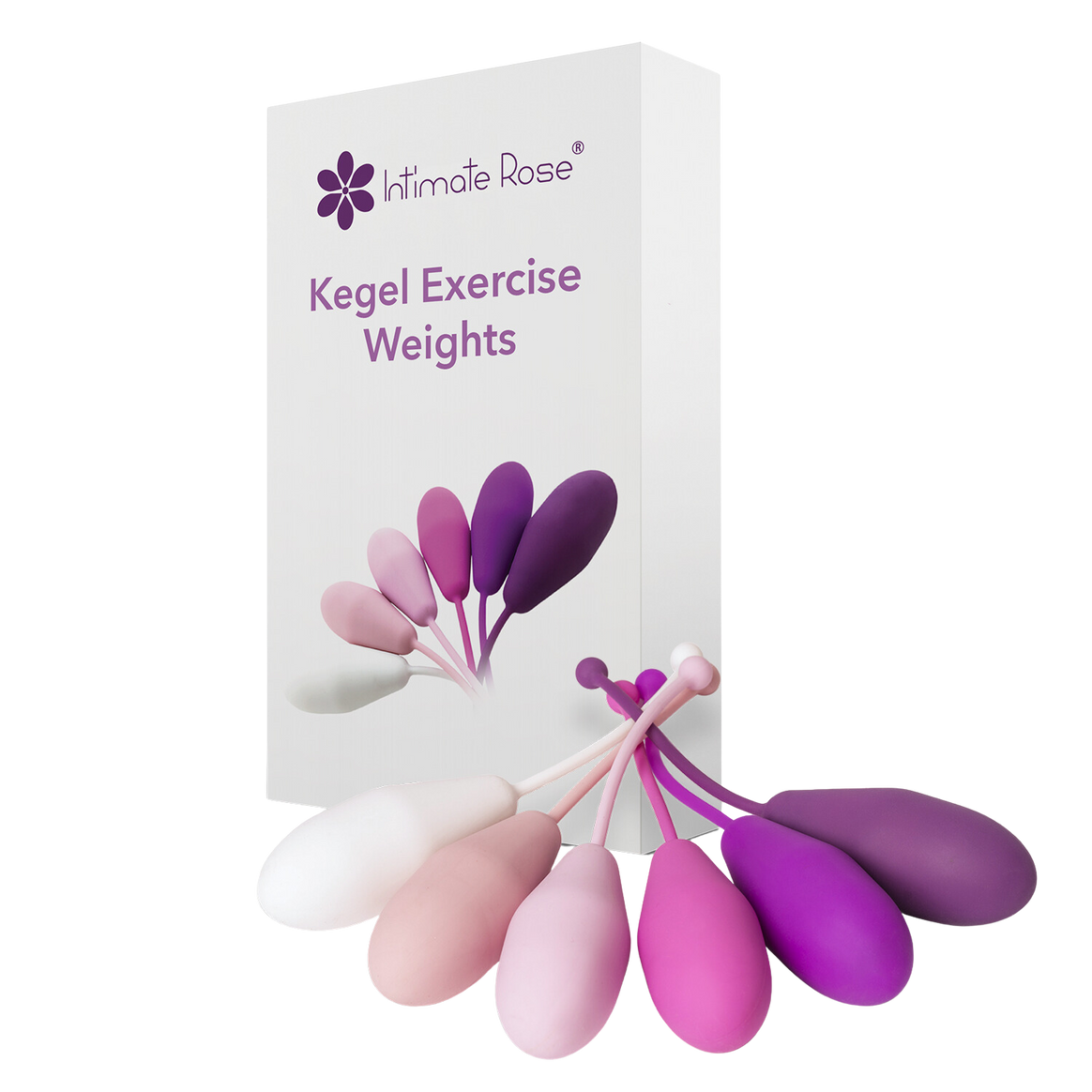The Pelvic Floor | Kegel Ball | How to | Best Exercises | Conclusion
If you’re leaking a little urine when you cough, jump, laugh or sneeze you may have an issue with weak pelvic floor muscles. According to recent studies, over 30% of women will experience a pelvic floor disorder during their lifetime.
But fear not, urinary incontinence associated with weak pelvic floor muscles can be managed by targeting the pelvic floor muscles with specific exercises known as Kegels.
Add some extra resistance training in the form of Kegel weights or Kegel balls, and you’ll notice a significant difference in bladder control as well as sexual pleasure.
To learn more about Kegels, Kegel balls, and how they help to strengthen the pelvic floor muscles, read on. You’ll also find guided instructions on how to do the best Kegel ball exercises, according to a pelvic floor physical therapist.
What Is the Pelvic Floor, Where Is it, And How Does It Weaken?
The pelvic floor is made up of muscles and connective tissues that help to stabilize your core while standing, moving, and sitting. They also support essential bodily functions such as bowel movements, sex, and urinating.
Physically, the pelvic floor muscles and tissues reach from the pubic bone at the front of the body to the tailbone at the back and left to right from sit bone to sit bone.
When strong, these muscles essentially act as a supportive sling or hammock for the pelvic organs such as; the bladder, bowel, intestines, rectum, and urethra. In female bodies, the pelvic floor muscles also support the cervix, uterus, and vagina.
How do the pelvic floor muscles weaken? Certain life experiences like pregnancy, childbirth, hormonal changes during menopause, pelvic trauma, and weight gain are typically the root cause.
Poor posture, weak abdominals or glutes, and long-term constipation can also contribute to a weak pelvic floor.
Pelvic Floor Disorders
Pelvic floor disorders that are caused by weak pelvic floor muscles include, but are not limited to, the following:
- Urinary Incontinence
- Fecal Incontinence
- Urgency Urinary Incontinence
- Overactive Bladder
- Pelvic Organ Prolapse

45-Min Online Pelvic Therapy Session, $99

45-Min Online Pelvic Therapy Session, $99
What Is A Kegel Ball?
Also known as vaginal weights or Kegel weights, Kegel balls are used to strengthen and re-train the pelvic floor muscles when they have been weakened and are no longer supporting the pelvic organs. Made with smooth medical-grade silicone that feels comfortable inside the body, Kegel weights (or balls) are designed to fit in the vagina like a weighted tampon.
Once inserted, the pelvic floor muscles are engaged to keep the weight in place. To begin with, just keeping the kegel weight in place for 10-15 minutes will suffice. And as soon as you feel comfortable holding the vaginal weights in place, you can progress to the Kegel ball exercises recommended by pelvic floor physical therapists.
To allow for continued training and strengthening, Kegel weights are generally sold in sets of ascending weights. Similar to how you would progress with heavier weights when training your biceps or triceps at the gym, Kegel weights are used in the same way.
Only when you have become comfortable holding each weight in place for 10-15 minutes will you progress to the next weight and repeat the process.
The Benefits of Kegel Ball Exercises For The Pelvic Floor
Similar to training any other muscles in the body, strengthening the pelvic floor muscles with Kegel ball exercises will enable them to function better. This means that they can provide adequate support for the pelvic organs, which, in turn, improves bladder & bowel control, and minimizes urine or fecal leaks.
Through research, women’s health experts have also found that strengthening the pelvic floor muscles with Kegel weight exercises substantially improves the quality of women’s sex lives and orgasms.
Relieving lower back pain and releasing the sensation of “tight hips” is another benefit of regular Kegel weight exercises. Additionally, because the pelvic muscles help to stabilize the core, most women who practice regular Kegel ball exercises report an improvement in their overall posture too.
How to Do A Kegel Correctly
Before getting into Kegel ball exercises, it’s best to become accustomed to doing a regular Kegel exercise first. To do this:
- Lie down on your back (without the Kegel weight)
- Gently insert a third of your first finger into your vagina (approximately 2cm).
- As if you are trying to stop the flow of urine, contract the muscles around the vagina producing a squeeze in the vagina and anus, but leave the abdominals, buttocks, and thighs relaxed.
- The tightness that you feel around your finger is the first part of a Kegel – i.e. the contraction.
- Hold here, breathing gently, for 3-5 breaths.
- Release and breathe normally for 3-5 seconds.
- The relaxation of the pelvic floor muscles is the second part of a Kegel – i.e. the release.
Without the insertion of your finger, repeat the process 10-15 times, three times a day for a few days to get used to the process of contracting & releasing that you will eventually do with the Kegel weights.
How To Insert Kegel Weights or Kegel Balls
Now that you know how to perform safe Kegels to re-train your pelvic floor muscles, you are ready to start using Kegel weights. To insert them accurately, follow the instructions below:
- With the Kegel weight generously covered in water-based lubricant, lie down on your back with your knees and feet wide.
- Take an inhale and as you exhale gently guide the Kegel weight about 2cm into your vagina.
- Allow the retrieval string to dangle outside of the vagina to allow for easy removal.
- Taking a few slow relaxing breaths, squeeze your vagina & anus to lift the pelvic floor muscles and contract them around the Kegel weight and keep it in place.
- Continue to breathe consciously and gently, feeling your inhale and exhale as you relax into the sensation of the weight being inside your body.
Top Kegel Ball Exercises To Strengthen The Pelvic Floor
Once you are comfortable inserting your Kegel weight and holding it in place, you can improve the endurance of your pelvic floor muscles and strengthen them to activate faster by performing the following Kegel weight exercises.
Kegel Ball Exercises Laying On the Back With Knees Bent
- Lay down on your back with your feet on the floor & hip distance apart.
- Insert your Kegel weight as per the instructions above and engage the pelvic floor muscles to hold it in place.
- Take a few breaths and get used to the feeling of the weight within your body.
- On an inhale, imagine that the urethra is a telescope.
- As you exhale, sense your vagina & anus squeezing and pulling that telescope further into your body. (Don’t worry, the weight will not move any further into your vaginal canal. It’s just a contraction of the muscles).
- Breathe gently and hold the contraction of the pelvic floor muscles for 5 seconds.
- Release the contraction with an inhale.
- Repeat the contract & release motion 10 times, up to three times per day.
Kegel Ball Exercises On All Fours
- Insert your Kegel weight by following the instructions above.
- Slowly move on to all fours, placing your hands on the floor under your shoulders and your knees under your hips. (You will feel the Kegel weight slip to the front of your pelvis in this position.)
- Take a few breaths and get used to the feeling of the weight within your body.
- On an inhale, imagine that the urethra is a telescope.
- As you exhale, sense your vagina & anus squeezing and pulling that telescope further into your body.
- Breathe gently and hold the contraction of the pelvic floor muscles for 5 seconds.
- Release the contraction with an inhale.
- Repeat the contraction & release 10 times, up to three times per day.
While performing Kegel ball exercises on all fours, keep your body still, the only movement should be your pelvic floor muscles contracting and relaxing.
Kegel Ball Exercises While Standing
Once you feel confident performing the Kegel weight exercises lying on your back and all fours, you are ready to move into a standing position.
When lying down or on all fours, gravity is not working against you, so the Kegel weight is easier to hold in place.
However, in a standing position, gravity pulls on the weight and could cause it to fall out, so the contraction of the pelvic floor muscles needs to be more powerful in a standing position, thus strengthening the muscles even more.
To practice Kegel weight exercises while standing (or walking around doing light chores):
- Insert the Kegel weight or ball as per the instructions above.
- Take a few breaths and get used to the feeling of the weight within your body.
- On an inhale, imagine that the urethra is a telescope.
- As you exhale, sense your vagina & anus squeezing and pulling that telescope further into your body.
- Breathe gently and hold the contraction of the pelvic floor muscles for 5 seconds.
- Release the contraction with an inhale.
- Repeat the contraction & release 10 times, up to three times per day for 10-15 minutes in a standing position or while you do light household chores.
Pelvic Floor Training Using a Complete Kegel Weight Set
Once you are comfortable practicing 10 repetitions of the above-mentioned Kegel weight exercises 2-3 times per day with the lightest weight in your set, you will be ready to progress to the next size.
Beginning with the next size weight means starting again with the three exercises until you are confident doing 10 repetitions of each 2-3 times per day.
Repeat this process with each ascending weight until you are confident and comfortable doing Kegel ball exercises with the last weight in your set.
Then, to keep your pelvic floor strong, continue to practice regular Kegel exercises with the heaviest weight 2-3 times per day. To prevent incontinence and maintain sexual pleasure, many women practice regular Kegel exercises for the rest of their life.
Kegel Weights

Conclusion
Performing regular Kegels to strengthen your pelvic floor muscles will marginally help with incontinence and sexual pleasure, but adding Kegel weights or Kegel balls is an absolute game changer. Similar to how weights at the gym will train and tone muscles on every other part of your body, vaginal weights can do the same for your pelvic floor.
To perform safe Kegels that correctly work your pelvic muscles, follow our instructions above and take things slow. For extra help with Kegel weight exercises, contact a pelvic health physical therapist in your area for more guidance.
References
UCLA Health – Pelvic Floor Disorders FAQs - https://www.uclahealth.org/medical-services/womens-pelvic-health/patient-education/pelvic-floor-disorders
National Institute of Health – Pelvic Floor - https://www.nichd.nih.gov/health/topics/pelvicfloor/conditioninfo
WebMD – What Is Pelvic Floor Physical Therapy - https://www.webmd.com/women/what-is-pelvic-floor-physical-therapy
North American Menopause Society - 3 Ways to Strengthen Your Pelvic Floor For Better Sex - https://www.menopause.org/for-women/menopauseflashes/sexual-health/for-better-sex-3-ways-to-strengthen-your-pelvic-floor
National Association For Continence - What Is An Overactive Bladder - https://nafc.org/overactive-bladder/
American Pregnancy Association – Kegel Exercises After Childbirth - https://americanpregnancy.org/healthy-pregnancy/labor-and-birth/kegel-exercises/
Intimate Rose – 7 Benefits of Kegels For Women - https://www.intimaterose.com/blogs/kegel-exercise/7-benefits-of-kegels-for-women
Cochrane Library - Weighted vaginal cones for urinary incontinence - https://www.cochranelibrary.com/cdsr/doi/10.1002/14651858.CD002114.pub2/full

45-Min Online Pelvic Therapy Session, $99
















